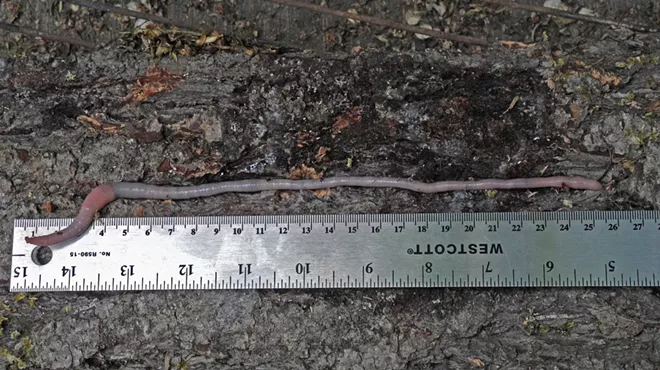"Giant white earthworm of the Palouse" sounds like a hoax or a Bigfoot-style myth. But unlike Bigfoot, Driloleirus americanus has been found alive by scientists. The rare earthworm reputedly grows up to 3 feet in length and was once said to be "abundant" in the fertile rolling hills of the Palouse, some two million agricultural acres of southeastern Washington and North Idaho that was once uncultivated prairie with thick deposits of topsoil.
The worms dig deep -- maybe as deep as 15 or 20 feet -- and they are white, like albinos, instead of the more familiar pink. They reportedly give off a smell like lilies and will spit at you if provoked.
& lt;span class= & quot;dropcap & quot; & D & lt;/span & ing Johnson has probably seen more of the living worms than any man alive. In 1988, he and a graduate student named Paul Johnson (no relation) -- both of them experts in insects, not worms -- were looking for beetles at a place called Moscow Mountain, a peak that rises about 2,500 feet above Moscow, Idaho. Its forested slopes aren't like the smooth Palouse hills, and it's not the kind of habitat thought to be friendly to white worms. But the two Johnsons flipped over a chunk of moss and found six of the rare worms. They captured two. Johnson never smelled the lily scent, but he says one did spit at him. (Yes, worms have mouths. Anuses too.)
The giant white's existence in science dates to 1898, when one was sent to experts for identification. Through the decades, there were stories and anecdotes about worm finds, mostly by non-scientists. That supposedly 3-foot-long Palouse worm? Johnson says it was measured after a kid had been swinging it around like a lariat, so the truth of its size literally might have been stretched.
In 1978, a worm expert from Oregon found two. A decade after that was the Johnsons' bonanza. Then for 17 years, all was quiet on the worm front, until 2005, when a University of Idaho grad student named Yaniria Sanchez-de Leon, digging for worms in a remnant of Palouse prairie at a place called Smoot Hill, found one of the rare white creatures. Well, actually she found two halves of it, because she'd accidentally cut it in half with her shovel. It was an important find tinged with tragedy, kind of like finding a Sasquatch as road kill.
Nevertheless, the find generated excitement in the scientific community. The worm corpse was sent to the Northwest's foremost worm expert -- William Fender-Westwind, the guy who found two great whites in 1978.
A true old-school scientific character, Fender-Westwind is no academic but a well-respected man who carries on a family tradition of amateur science. His mother is also a worm expert with a huge collection of specimens kept in a shed (claimed to be the largest such collection outside the Smithsonian). Her husband, a postman, was a recognized authority on soldier beetles. It was Fender-Westwind who autopsied Sanchez-de Leon's find and confirmed, in 2006, that it was indeed a great white.
It's now nearly two years since that identification, and no more Palouse worms have been seen. Not even in the places where they've been spotted previously.
& lt;span class= & quot;dropcap & quot; & J & lt;/span & odi Johnson-Maynard (no relation to either Johnson previously mentioned) is the other prof in the office. She is associate professor of soil and water quality at the university. As a soil biologist, worms are definitely her turf, and Sanchez-de Leon was one of her grad students. She hands me a test tube about 6 inches long, filled with fluid and corked at the top. Inside floats the off-white corpse of a Palouse giant. It looks something like a pickled wax bean. It has a vertical seam, an incision from the autopsy. It looks crinkled and traumatized -- no surprise given its violent, if accidental, end. For a major scientific enigma, it seems a bit forlorn.
Because this earthworm is so rare, little is known about it. Scientists don't know where it lives, how abundant it is (or was), what its life span is, how big it gets, or how it behaves. Researchers are working on hunches. Most earthworms you find now in the Northwest are non-natives. Yes, the wriggling pink thing in your garden is probably an invader from Europe, just like most of us. (Wasn't it the alchemists who said, "As above, so below"?) The giant Palouse earthworm may be the only native worm species in the Columbia River Basin, says Johnson-Maynard. If so, you have to be careful how much you infer about its behavior and characteristics from other worms.
And researchers' hands are somewhat tied for another reason. To truly understand a population of earthworms, you need to collect and study a fairly large sample of them. Finding great whites is obviously problematic. But also their likely habitat -- remnants of the original Palouse prairie -- is rare and fragile, too. You might endanger important prairie patches by going all-out to dig for worms, with no assurance of finding any. And it was digging that might have reduced the worm population in the first place. If they were truly abundant in the Palouse hills a century ago, 100 years of plowing might have been the coup de grace.
That, of course, is a major question. The U.S. Fish and Wildlife Service declined to list the giant white Palouse earthworm as an endangered species. Palouse preservationists say they will appeal that decision.
The stakes could be high. If listed, the great white worm could become the spotted owl of the Palouse, also impacting adjacent areas where they've also been found, like Moscow Mountain. The implications for agriculture and development could be significant. Of course, the implications for the worm could be terminal.
It seems odd that you have to prove that an animal that's so hard to find is endangered, but rarity itself isn't proof enough. They could be thriving in unknown locations. Plus, if you don't know the worm's habits or needs, how can you manage the ecosystem to "save" it? Johnson-Maynard has been back to known worm sites to look for more great whites -- a "worm quest," she calls it -- and she plans to do much more investigating.
Ding Johnson says, "We don't know enough to say they are endangered." He adds, "Hunch is an important factor in our knowledge of this worm.... When you're working on hunch, it drives scientists crazy."
I handed the worm vial back to Johnson-Maynard reluctantly. I felt as if holding on to it would have the talismanic effect of curing my ignorance. My hunch is that the great white will be a kind of scientific brain worm for a lot of people for some time to come. It'll take solving its mysteries to get its song out of their heads.
Knute Berger is a Seattle-based writer. This article first appeared on Crosscut.com.















